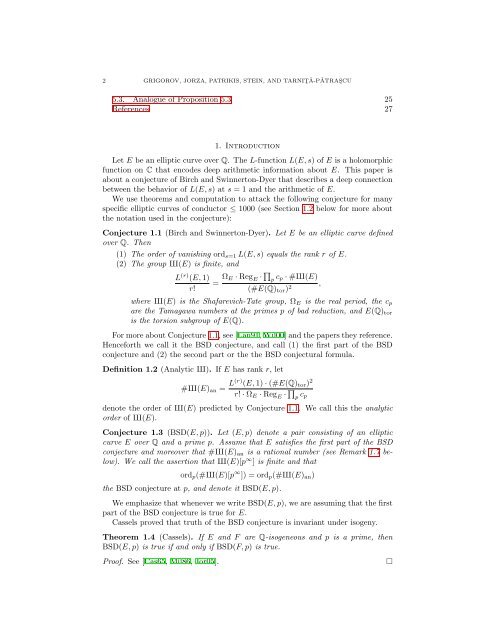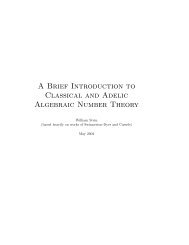COMPUTATIONAL VERIFICATION OF THE BIRCH ... - William Stein
COMPUTATIONAL VERIFICATION OF THE BIRCH ... - William Stein
COMPUTATIONAL VERIFICATION OF THE BIRCH ... - William Stein
You also want an ePaper? Increase the reach of your titles
YUMPU automatically turns print PDFs into web optimized ePapers that Google loves.
2 GRIGOROV, JORZA, PATRIKIS, STEIN, AND TARNIT¸ Ǎ-PǍTRAS¸CU<br />
5.3. Analogue of Proposition 5.3 25<br />
References 27<br />
1. Introduction<br />
Let E be an elliptic curve over Q. The L-function L(E, s) of E is a holomorphic<br />
function on C that encodes deep arithmetic information about E. This paper is<br />
about a conjecture of Birch and Swinnerton-Dyer that describes a deep connection<br />
between the behavior of L(E, s) at s = 1 and the arithmetic of E.<br />
We use theorems and computation to attack the following conjecture for many<br />
specific elliptic curves of conductor ≤ 1000 (see Section 1.2 below for more about<br />
the notation used in the conjecture):<br />
Conjecture 1.1 (Birch and Swinnerton-Dyer). Let E be an elliptic curve defined<br />
over Q. Then<br />
(1) The order of vanishing ords=1 L(E, s) equals the rank r of E.<br />
(2) The group X(E) is finite, and<br />
L (r) (E, 1)<br />
r!<br />
= ΩE · Reg E · <br />
p cp · #X(E)<br />
(#E(Q)tor) 2 ,<br />
where X(E) is the Shafarevich-Tate group, ΩE is the real period, the cp<br />
are the Tamagawa numbers at the primes p of bad reduction, and E(Q)tor<br />
is the torsion subgroup of E(Q).<br />
For more about Conjecture 1.1, see [Lan91, Wil00] and the papers they reference.<br />
Henceforth we call it the BSD conjecture, and call (1) the first part of the BSD<br />
conjecture and (2) the second part or the the BSD conjectural formula.<br />
Definition 1.2 (Analytic X). If E has rank r, let<br />
#X(E)an = L(r) (E, 1) · (#E(Q)tor) 2<br />
r! · ΩE · Reg E · <br />
p cp<br />
denote the order of X(E) predicted by Conjecture 1.1. We call this the analytic<br />
order of X(E).<br />
Conjecture 1.3 (BSD(E, p)). Let (E, p) denote a pair consisting of an elliptic<br />
curve E over Q and a prime p. Assume that E satisfies the first part of the BSD<br />
conjecture and moreover that #X(E)an is a rational number (see Remark 1.7 below).<br />
We call the assertion that X(E)[p ∞ ] is finite and that<br />
ordp(#X(E)[p ∞ ]) = ordp(#X(E)an)<br />
the BSD conjecture at p, and denote it BSD(E, p).<br />
We emphasize that whenever we write BSD(E, p), we are assuming that the first<br />
part of the BSD conjecture is true for E.<br />
Cassels proved that truth of the BSD conjecture is invariant under isogeny.<br />
Theorem 1.4 (Cassels). If E and F are Q-isogeneous and p is a prime, then<br />
BSD(E, p) is true if and only if BSD(F, p) is true.<br />
Proof. See [Cas65, Mil86, Jor05].
















